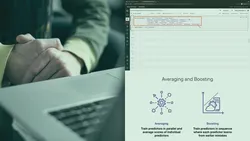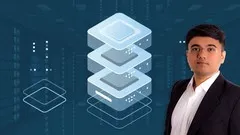
Getting Started with Apache Spark on Databricks 
This course provides an introduction to Apache Spark on Azure Databricks, covering topics such as Spark transformations, actions, visualizations, and functions. Participants will gain hands-on experience with big data processing and analytical queries. ▼
ADVERTISEMENT
Course Feature
![]() Cost:
Cost:
Free Trial
![]() Provider:
Provider:
Pluralsight
![]() Certificate:
Certificate:
Paid Certification
![]() Language:
Language:
English
![]() Start Date:
Start Date:
On-Demand
Course Overview
❗The content presented here is sourced directly from Pluralsight platform. For comprehensive course details, including enrollment information, simply click on the 'Go to class' link on our website.
Updated in [February 21st, 2023]
(Please note the following content is from the official provider.)
This course will introduce you to analytical queries and big data processing using Apache Spark on Azure Databricks. You will learn how to work with Spark transformations, actions, visualizations, and functions using the Databricks Runtime.
Azure Databricks allows you to work with big data processing and queries using the Apache Spark unified analytics engine. With Azure Databricks you can set up your Apache Spark environment in minutes, autoscale your processing, and collaborate and share projects in an interactive workspace. In this course, Getting Started with Apache Spark on Databricks, you will learn the components of the Apache Spark analytics engine which allows you to process batch as well as streaming data using a unified API. First, you will learn how the Spark architecture is configured for big data processing, you will then learn how the Databricks Runtime on Azure makes it very easy to work with Apache Spark on the Azure Cloud Platform and will explore the basic concepts and terminology for the technologies used in Azure Databricks. Next, you will learn the workings and nuances of Resilient Distributed Datasets also known as RDDs which is the core data structure used for big data processing in Apache Spark. You will see that RDDs are the data structures on top of which Spark Data frames are built. You will study the two types of operations that can be performed on Data frames - namely transformations and actions and understand the difference between them. You'll also learn how Databricks allows you to explore and visualize your data using the display() function that leverages native Python libraries for visualizations. Finally, you will get hands-on experience with big data processing operations such as projection, filtering, and aggregation operations. Along the way, you will learn how you can read data from an external source such as Azure Cloud Storage and how you can use built-in functions in Apache Spark to transform your data. When you are finished with this course you will have the skills and ability to work with basic transformations, visualizations, and aggregations using Apache Spark on Azure Databricks.
(Please note that we obtained the following content based on information that users may want to know, such as skills, applicable scenarios, future development, etc., combined with AI tools, and have been manually reviewed)
What skills and knowledge will you acquire during this course?
This course, Getting Started with Apache Spark on Databricks, will provide learners with the skills and knowledge to understand the fundamentals of Apache Spark and how to use it for big data processing and analysis. Learners will gain an understanding of the Spark architecture and how it is configured for big data processing, as well as the Databricks Runtime on Azure and how it makes it easy to work with Apache Spark on the Azure Cloud Platform. Additionally, learners will learn about the Resilient Distributed Datasets (RDDs) which is the core data structure used for big data processing in Apache Spark, and the two types of operations that can be performed on Data frames - transformations and actions. They will also gain hands-on experience with big data processing operations such as projection, filtering, and aggregation operations, and learn how to read data from an external source such as Azure Cloud Storage and how to use built-in functions in Apache Spark to transform their data. By the end of this course, learners will have the skills and ability to work with basic transformations, visualizations, and aggregations using Apache Spark on Azure Databricks.
How does this course contribute to professional growth?
This course provides learners with the skills and knowledge necessary to work with Apache Spark on the Azure Cloud Platform. It covers the fundamentals of Apache Spark, the Spark architecture, and how to use the Databricks Runtime on Azure. Learners will gain hands-on experience with big data processing operations such as projection, filtering, and aggregation operations. Additionally, learners will learn how to read data from an external source such as Azure Cloud Storage and how to use built-in functions in Apache Spark to transform their data. By the end of this course, learners will have the skills and ability to work with basic transformations, visualizations, and aggregations using Apache Spark on Azure Databricks. This course contributes to professional growth by providing learners with the skills and knowledge necessary to work with Apache Spark on the Azure Cloud Platform, which is a valuable skill in the field of big data processing and analysis.
Is this course suitable for preparing further education?
This course is suitable for preparing further education in Apache Spark and big data processing. It covers the fundamentals of Apache Spark and how to use it on the Azure Cloud Platform. Learners will gain an understanding of the Spark architecture, the Resilient Distributed Datasets (RDDs), and how to perform transformations and actions on data frames. Additionally, learners will gain hands-on experience with big data processing operations such as projection, filtering, and aggregation operations. Finally, learners will learn how to read data from an external source and use built-in functions in Apache Spark to transform their data. By the end of this course, learners will have the skills and ability to work with basic transformations, visualizations, and aggregations using Apache Spark on Azure Databricks.
Course Provider

Provider Pluralsight's Stats at AZClass
Pluralsight ranked 16th on the Best Medium Workplaces List.
Pluralsight ranked 20th on the Forbes Cloud 100 list of the top 100 private cloud companies in the world.
Pluralsight Ranked on the Best Workplaces for Women List for the second consecutive year.
AZ Class hope that this free trial Pluralsight course can help your Databricks skills no matter in career or in further education. Even if you are only slightly interested, you can take Getting Started with Apache Spark on Databricks course with confidence!
Discussion and Reviews
0.0 (Based on 0 reviews)
Explore Similar Online Courses

Linux Commands & Shell Scripting

Deep Learning with Python and PyTorch

Python for Informatics: Exploring Information

Social Network Analysis

Introduction to Systematic Review and Meta-Analysis

The Analytics Edge

DCO042 - Python For Informatics

Causal Diagrams: Draw Your Assumptions Before Your Conclusions

Whole genome sequencing of bacterial genomes - tools and applications

Databricks Fundamentals & Apache Spark Core

Databricks Essentials for Spark Developers (Azure and AWS)


Start your review of Getting Started with Apache Spark on Databricks